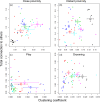Group-level signatures in bonobo sociality
- PMID: 39712879
- PMCID: PMC11660378
- DOI: 10.1017/ehs.2024.44
Group-level signatures in bonobo sociality
Abstract
Humans show remarkable differences in social behaviour between families, groups, communities and cultures, whereas such group-level within-species variation in socio-behavioural propensities is typically overlooked in other species. Studies on intraspecific variation in animal social structures are needed to inform an evolutionary account of human sociality. Here, we study multiple independent bonobo populations (n = 6) in zoological settings to investigate if and how bonobos (n = 70) show group-specific signatures in sociality. By applying tailored Bayesian statistical methods, we find that beyond individual and dyadic variation, the groups substantially differ from each other in core dimensions of great ape sociality: social proximity, grooming and play. Moreover, the groups' network structures are distinct regarding cohesiveness and clustering, with some groups forming cohesive wholes, while others showcasing high levels of sub-grouping. Overall, while there is consistent evidence of differences in sociality between the groups, the patterns of cohesiveness and clustering are not consistent across the networks. This suggests that rather than groups having different levels of sociality, different patterns of sociality exist in each group. These findings warrant caution with characterising bonobos' behavioural phenotype at the species level, and identify an essential source of variation that needs to be integrated in phylogenetic analyses.
Keywords: Bonobos; Pan paniscus; group-level variation; intraspecific variation; sociality.
© The Author(s) 2024.
Conflict of interest statement
The authors declare to have no competing interests.
Figures



References
-
- Balasubramaniam, K. N., Beisner, B. A., Berman, C. M., De Marco, A., Duboscq, J., Koirala, S., …, McCowan, B. (2018). The influence of phylogeny, social style, and sociodemographic factors on macaque social network structure. American Journal of Primatology, 80(1), e22727. 10.1002/ajp.22727 - DOI - PubMed
LinkOut - more resources
Full Text Sources
Research Materials
Miscellaneous
